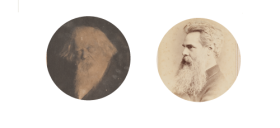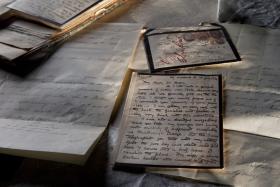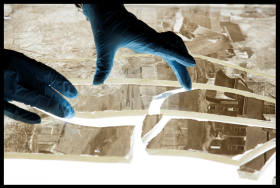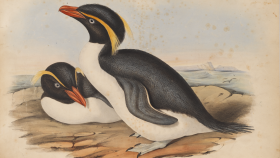‘You are such an old friend’, wrote Thomas Woolner to Henry Parkes from London in 1892, ‘and nearly all my old friends are dead [so] my interest concentrates upon the few stragglers left, and I cannot employ my holiday more to my mind than gossiping with you whether you like to read or not.’
With this playful intimacy, Thomas Woolner closed what would be the last of his letters to Sir Henry Parkes; the conclusion to a correspondence that spanned more than 40 years. Woolner, an original Pre-Raphaelite and up-and-coming sculptor, had met Henry Parkes while living in New South Wales in the mid-1850s, having failed to strike gold in Victoria.
Portions of this fascinating correspondence have informed my research on Woolner’s place in art history, from the sculptor’s reflections on the Pre-Raphaelite movement, to the ‘remote drama’ (as Woolner tactfully termed it) of his botched commission for Hyde Park’s Captain Cook statue. Yet, despite these scholarly revelations, as I sat riveted by this archive of letters in the Mitchell Library I found myself affected by aspects of the correspondence which might not find a place in mainstream scholarship.
During my time as the Library's CH Currey Memorial Fellow, I transcribed this fascinating record of a friendship — nearly 22,000 words on Woolner’s side alone. The letters reflect upon Woolner’s time in Australia in the 1850s, consider the role of sculpture and the arts in England and Australia, discuss imperial and colonial politics, and shed light on Woolner’s family life. But they provide something more: an archive of emotion and close friendship between two eminent men on opposite sides of the globe.
It is the everyday ‘chat’, in Woolner’s words, that we encounter in letters and diaries which connects us most palpably with the past. Inscribing significance to the Parkes–Woolner correspondence as the record of a friendship helps to rehabilitate the pivotal role of personal relationships in creating colonial networks, and to trace the intellectual and emotional lives of the correspondents. We meet Woolner the man rather than, as the late nineteenth-century press called him, the ‘poetic sculptor’, and see glimpses of Parkes as a ‘poet premier’ rather than the Father of Australian Federation.
From the beginning, the relationship was mutually beneficial. Parkes assisted Woolner in securing colonial commissions and his support for Woolner’s sculpture demonstrated his commitment to fostering artistic culture in the colony. The conversation between the two men helped to shape their opinions; Parkes asked Woolner for his political views on Federation, while Woolner frequently requested Parkes’ critique of his poetry (‘I treasure up what my friends say of my verses’, wrote Woolner, ‘and [my] children take interest in what they hear has been said.’) Parkes, who published several volumes of letters, prose and poetry, also found his poetry benefitting from Woolner’s critical pen.
Woolner and his family kept Parkes connected with developments in literary London; and Woolner’s wife Alice (née Waugh) passed Parkes’ poetry on to poet laureate Alfred Tennyson whose son Hallam viewed Parkes as something of a colonial hero. Tennyson, in turn, extended his friendship and invited Parkes to stay during his 1882 visit to England. In this way, through his friendship with Woolner, Parkes was able to participate in global literary conversations from his home in Sydney.
In later life, Woolner was frustrated by the declining cultural value of sculpture, and the correspondence helped him work through his feelings of isolation in London. He divulged his emotional life with perhaps more candour than he would have to friends closer to home and, at one stage in 1879, even sought Parkes’ help to relocate his family, writing, ‘I yearn for the constant azure skies of cheerful Sydney’.
Parkes collected celebrity autographs — perhaps to maintain a sense of connection with the imperial centre — and Woolner frequently ‘hunted’ celebrities down, as he put it, to procure autographs for his friend. Woolner also sent tokens to the Parkes family, such as in 1879 when he sent a cameo based on a relief rendering of Sydney’s Captain Cook for Lady Parkes to wear. Even small animals were gifted between the families. Parkes gave a bullfinch, thrush and dormouse to the Woolners when he visited London in 1884–85 and regular updates on the animals were sent in the ensuing correspondence. ‘The dormouse is flourishing, fat, and sleepy,’ wrote Woolner in February 1885, ‘– but, sad to say, the poor little Bully is dead. It was a great favourite, used to hop from its cage and settle on Clare’s hand and feed with evident delight. – The thrush is fat and bright-eyed as ever, and soon I hope to hear him pipe up as this is the first morning of spring.’
The trajectory of the relationship between the two men, from pragmatism to deep feeling and familial connection, was mirrored by my own relationship to this archive. Initially motivated by professional inquiry, I found myself developing great affection for Parkes and Woolner. My heart sank — presumably like Parkes’ before me — whenever I turned the page to encounter the black-framed mourning stationery that signalled a death in the family; the sudden death of Woolner’s son at school in 1882, for instance, which devastated Woolner and his wife.
‘[T]ho’ I was telegraphed for and used my utmost speed’, wrote Woolner, ‘the poor boy was dead and had been 7 hours and a half before I reached the place. My wife is almost broken hearted and cannot be comforted. Men are forced to attend to the duties of life, and in these dreadful trials are therefore better off than women. He was the child who was so anxious for your autograph.’
As I progressed through the yellowed pages of the letterbook, the scholar within me should have been pleased. But I watched the remaining pages diminish with a sense of sadness that the lives of both men were drawing to a close. Woolner’s final letter to Parkes was written just before his death in 1892. He began, ‘I write not because I have anything especial to say, but for the sake of “Auld lang syne”,’ and continued:
My family are all away in the country, and I remain a jolly bachelor, which as no women are present, I venture to say, is not such a bad thing after all. What a pity we cannot alternate with the two things at will, as we do in politics, sometimes Radicals, and sometimes Tories. The nation gets on all the better for these changes and why should not we? Give him a woman and each man contains the potentiality of a nation! Therefore I maintain the simile is good.
The warmth that had developed between the men is evident in this excerpt; the ‘chat’ or ‘gossip’ which saw their friendship outlast terms of government, sculptural commissions, and even marriages. It also demonstrates the privileged place of the scholar in reading the private writings of eminent people; and points to the ease with which a reader might develop an emotional attachment to historical figures through their correspondence.
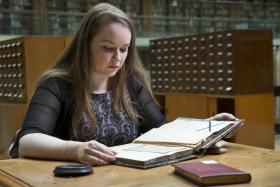
Dr Angela Dunstan was the State Library’s 2012 CH Currey Memorial Fellow.

